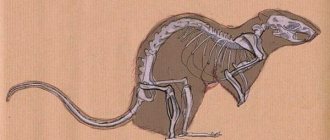- home
- General information
23.03.2018
Before you go to the store to buy a hamster, you need to know about the health of the animal. This will help you avoid buying a sick animal and help you be on guard. After all, if you buy a sick pet and don’t know about it, it can die within a month after purchase. Serious diseases include a wet tail in a hamster. When choosing a pet, pay attention to its backside. Sputum may indicate illness.
General description of the disease
Wet hamster tail is a disease that every self-respecting hamster breeder should know about. Syrian hamsters are susceptible to this disease, so to speak, this is their specific disease. You need to understand that “Wet tail” is a very dangerous disease that threatens the life of your pet. This is due to the severe course of the disease, high contagiousness (infectious disease) and a high mortality rate even with proper treatment by a veterinarian, let alone self-medication.
How to treat correctly
The main therapy that veterinarians prescribe for hamsters with wet tail disease is taking antibiotics. Most often, doctors prescribe the drug Baytril. According to the instructions, the medicine is injected under the skin. The dose of the drug is determined at the rate of 0.4 ml per 1 kg of body weight. Injections are given 1-2 times a day for 1-2 weeks. The veterinarian prescribes the exact treatment regimen.
The range of medications includes the following medications.
- "Dolphos." Give the animal 0.5–1 scoop per day, adding the drug to food.
- "Olin." Divide the solution in the bottle into 7 doses. Give one part of the drug from a pipette every day for a week.
- "Lactoferon". Dissolve 1 tablet in water or mix with food. The course of treatment is 5–10 days, once a day.
The owner can independently choose one of the remedies, but it is better to ask a doctor’s opinion.
Symptoms
The most important symptom of “wet tail” is contained in the very name of the disease. This wet rear part of the hamster (tail and fur around) is caused by severe diarrhea, due to disruption of the digestive system. It can be confused with ordinary diarrhea, but this disease is also characterized by a very unpleasant odor, which does not occur with ordinary diarrhea, the hamster behaves more aggressively, irritable, may begin to bite, run around the cage, and the fur is disheveled. This general appearance suggests a “wet tail.” Also, a sick hamster refuses food and water, which aggravates the situation, because as a result of diarrhea, his body becomes severely dehydrated.
If nothing is done, this disease leads in 90% of cases to a sad outcome for the hamster.
The causative agents of the disease can be different bacteria. The onset of the disease does not occur immediately after the pathogen enters the body - it takes up to two weeks (incubation period).
Why does infection occur?
The causative agent is an intestinal bacterium that spreads from a sick animal to healthy individuals, therefore, if the disease is suspected, quarantine is necessary. Poor-quality food stored without the necessary conditions, dirty water, wet and dirty bedding - this is a favorable environment for the development of infection.
Did you know? North American hamsters, like magpies, drag everything that glitters into their burrows, often stealing various objects from people.
What to do if you suspect a “wet tail”?
If you observe the above symptoms in your hamster, you need to immediately show him to a veterinarian; self-medication is extremely dangerous in any case.
Since we are dealing with an infectious and extremely contagious disease, you need to isolate the sick hamster, especially if you have more than one. Place your pets separately, for example, in 3-liter jars. Throw away everything that was in the cages (food, bedding). The cage should be treated with some kind of disinfectant (including the drum, feeder and drinking bowl).
Features of care
At the first suspicion of infection, a sick hamster must be separated from other individuals. They should also be temporarily moved to a separate cage, and the previous one should be disinfected. Any chlorine-containing solution is suitable for this purpose.
After treatment, the rodents' house should be thoroughly rinsed with clean water. All installed equipment – toys, feeders, drinking bowls – also require disinfection.
The cage of a sick individual should always be dry and warm. The temperature in the room is 21-26°C without drafts. Carry out daily cleaning with changing bedding.
All hygiene measures must be carried out with gloves, since bacteria can pass through the owner’s hands to healthy animals. During the period of treatment and recovery, vegetables and fruits should be excluded from the hamster’s diet. It is better to offer your pet grain food - wheat, oats, rye.
Treatment
The most correct option for your action in case of a “wet tail”, in terms of treatment, is to take it to the veterinarian as soon as possible. He, in turn, prescribes antibiotics, hydration therapy (restoring water balance), probiotics (to restore normal intestinal microflora, disturbed by infection and the influence of antibiotics). All these actions must be dosed and balanced, which is practically impossible to do at home on your own.
Unfortunately, even if you take your pet to the veterinarian in time for help, there is a very high mortality rate. Very often, hamsters do not survive the “wet tail”, and if they do survive, complications from the digestive system are possible in the form of various inflammatory processes. But, there is a third outcome - the hamster recovers and gains lifelong immunity to such a dangerous disease and no longer gets sick (with proper care and hygiene).
Which breeds are most susceptible to this disease?
The phenomenon is typical for all breeds of rodents due to the special structure of the gastrointestinal tract. But according to statistics, Syrian hamsters have a slightly higher percentage of infection due to their long hair, which is more difficult to clean from contamination.
In this case, individuals under the age of 12 weeks most often become ill. They have not yet sufficiently acquired the skill of cleaning their own wool and do not do it very carefully. This is also typical for older hamsters; in their case, the daily washing ritual takes a lot of energy.
Prevention
Prevention of this disease comes down to proper nutrition (which you can read about here), hamster hygiene and proper conditions of solitary confinement. After all manipulations with infected hamsters and their cage, be sure to treat your hands well!
Now you will know what a “wet tail” is in a hamster and in case of illness, contact your veterinarian for help in time.
Please rate the article
4.5833333333333 Rating 4.58 (18 votes)
- < Back
- Forward >
We will be very grateful if you share it on social networks. Thank you!
Comments
0 Khomka Rudik 08/31/2014 15:50 Can an Angora Khoma get sick?
Reply | Reply with quote | Quote | Report to moderator
+2 Hamster Crunchy! 09/03/2014 15:35 All hamsters, regardless of the variety, can get sick
Reply | Reply with quote | Quote | Report to moderator
-1 Lyoshik 01/30/2016 22:57 Yes! Angora hamsters are the same as Syrian hamsters, only with long hair. 
Reply | Reply with quote | Quote | Report to moderator
+5 Hamster Ksyusha 10/18/2014 08:10 My hamster has this problem now
Reply | Reply with quote | Quote | Report to moderator
+3 Fedor 12/24/2014 14:11 We treat homa with enterofuril 1 ml 3 times a day.
Reply | Reply with quote | Quote | Report to moderator
+3 vladimir 05/16/2015 21:17 The hamster has a red ball above his tail, what is it?
Reply | Reply with quote | Quote | Report to moderator
+8 Tane 07/03/2015 19:25 In addition to diarrhea, the hamster's left eye is half-closed, but there is no pus. The ears are pressed to the head, although they usually stick out. Appetite is good. He's kind of restless, rushing around the cage, stockpiling supplies. He just became thin and hunched over. I sat on dry food and water for two days and immediately began pooping normally. As soon as I gave her grass and carrots, after 3 days everything started all over again. What to do?
Reply | Reply with quote | Quote | Report to moderator
+4 Cutie 07/20/2015 20:19 Contact a veterinarian
Reply | Reply with quote | Quote | Report to moderator
+4 Elena V. 05.15.2016 12:46 Hello! I have an unclear problem... The hamster escaped from the cage, I couldn’t find it for 3 days, then he came on his own, one eye is half open, the whole hamster is stained with feces, and from the anus there is something sticking out that looks like feces, but something too big , voluminous and long... There is only one veterinary hospital in the city and, as luck would have it, they have a day off for two days... What to do with a hamster? What about him?
Reply | Reply with quote | Quote | Report to moderator
+3 Dora 06/13/2016 17:14 Hello. The Syrian hamster suddenly lost his tail! I don’t know what to think, she lives alone, we feed her fully, the bedding is pressed sawdust. no tail and that's it. What could it be? She is the same as she was in behavior. Help please, I'm very afraid for her
Reply | Reply with quote | Quote | Report to moderator
-3 Dora 06/13/2016 17:27 Hello. Help me please!! The Syrian hamster's tail is missing! I don’t know what to think, she alone couldn’t take a bite from us, and she couldn’t get confused either. Bedding made of pressed sawdust. Help me please! I'm very afraid for her!!!
Reply | Reply with quote | Quote | Report to moderator
0 Zinaida 07/26/2016 15:36 the homek has lost hair on its chest, what should I do?
Reply | Reply with quote | Quote | Report to moderator
+1 EvaUmka 08.08.2016 18:45 Hello! We don’t know what to do... our hamster is sick. she is 2 years old (perhaps even more, because we took her big, then she did not grow, and at the pet store they told us that she was 3 months old, they could have lied). lives with his mother. I saw her for the last time 2 weeks ago, everything was fine, then I went on a business trip, came back yesterday - she’s really bad (((right eye is half-closed, there’s a red sore on it, there are dry black growths on all the paws, like growths or dry sores, the paws themselves bald, wet tail, moves with difficulty, as if paralyzed (((but eats and drinks well. Veterinarians refuse to deal with hamsters, they say she’s old... Is this really true or is there any hope of a cure? What could it be?
Reply | Reply with quote | Quote | Report to moderator
+1 Miya 12/25/2016 1:33 pm With this disease, are hamsters constantly wet or not? Please answer!!!!! !!!!!!!!!
Reply | Reply with quote | Quote | Report to moderator
Update list of comments
Basic rules for keeping a rodent
In addition to the diet, the well-being of the jungar is influenced by the conditions of detention. The animal's cage must correspond to its size; in a cramped and small house the animal will be uncomfortable. The hamster must lead an active lifestyle, so it is necessary to provide it with special toys.
Who can cure a hamster? (list of veterinary clinics)
• • •
It's a pity, but most general veterinarians are completely incapable of treating hamsters, especially when it comes to a serious illness. Since dogs and cats are frequent and therefore profitable clients, all the attention of veterinary specialists turns to them. Meanwhile, the treatment of hamsters is very specific. Most veterinarians are unaware that the number of medications that can be given to hamsters can be counted on one hand. They can prescribe penicillin antibiotics, which cause anaphylactic shock and death in rodents.
What should I do to prevent bloating from appearing?
Simple rules to reduce the risk of flatulence:
- Eating should be slow, with thorough chewing of food, without distraction by extraneous actions.
- Avoid quick snacks on the go, smoking, and drinking alcohol.
- Limit the consumption of foods that increase gas formation.
- Avoid sugary carbonated drinks (there is nothing healthy in them).
- Drink enough clean water per day.
- Follow a proper diet (fried, fatty foods should not predominate)3.
Before a big feast or when overeating, it is better to take care of preventing bloating* in advance. To do this, you can take Creon® 10000 capsule with food or immediately after it. The active substances contained in the drug help natural digestion, reducing the risk of discomfort and heaviness after eating.
Causes of loose stools
Episodes of loose stools that plague a person for one or several days are not a separate disease. This is just one symptom of functional, organic or neural dysfunction. Loose stools that persist for a long time may be accompanied by other clinical manifestations: abdominal pain and cramps, fever, chills, nausea, vomiting, dizziness. It is on the basis of a set of symptoms that one can most accurately determine the cause of loose stools.







